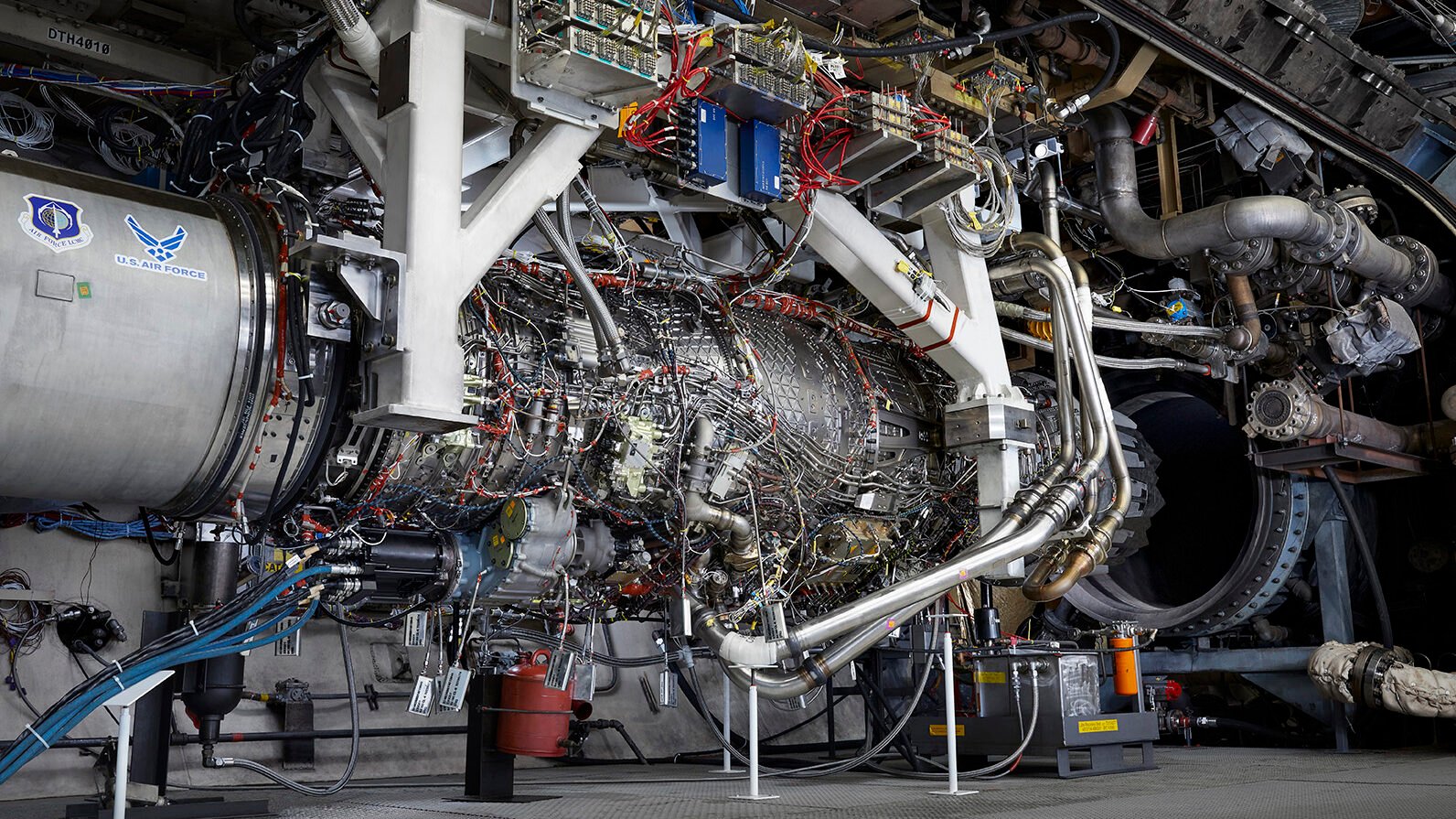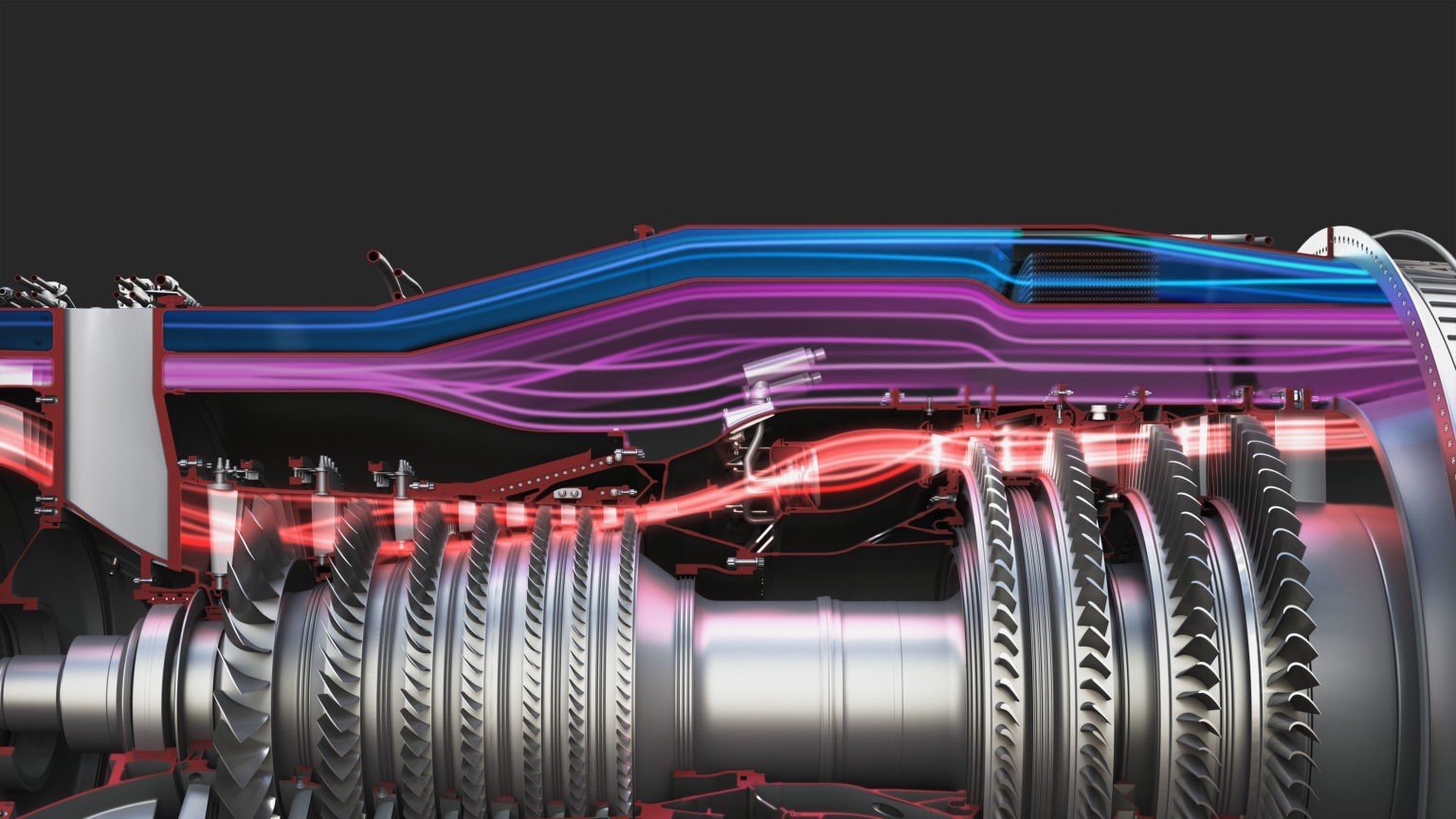
GE’s first XA100 prototype engine readies for testing in an Evendale, Ohio, test cell. (General electric)
FARNBOROUGH AIRSHOW: Since the early days of the F-35 Joint Strike Fighter, General Electric has been trying to grab onto the global F-35 engine market, but has been stymied at every turn. Something would happen with the plane’s Pratt & Whitney F135 design, and GE’s hopes would rise with talk of the need for a second engine, only to crash again after a few weeks.
Now, over 20 years years after Lockheed Martin’s F-35 design was chosen by the Pentagon to be its fifth-generation fighter, GE is trying again with a new engine — and, at least during a July 19 briefing with reporters, expressing cautious optimism about its XA100 design.
The Pentagon stopped funding General Electric’s F136 engine in 2011, leaving the Pratt & Whitney F135 as the sole propulsion option for the F-35. However, the F-35 will need an improved engine to support oncoming Block 4 enhancements that will make the jet more lethal, and department officials are contemplating whether another competition between the former rivals could lead to a massive leap forward in engine capability at a price the services can afford.
The F-35 Joint Program Office is expected to make a decision sometime in the next year about whether to move forward with a new engine design for the fighter.
RELATED: F-35 Engine Rivals Prepare For Another Clash
“From GE’s perspective, we really think that this is a critical decision point, and the decision is ‘What does the future of F-35 propulsion look like?’” said David Tweedie, vice president and general manager of advanced products for GE’s Edison Works division. “I think the one thing that probably all of industry and most of government will agree on is that something needs to be done. The debate is what path do you go on?”
The stats claimed by GE are impressive: 30% increase in range, 20-40% improvement in kinetic performance, and the ability to double the energy output for on-board systems, a growing need as the department plays around with concepts like directed energy systems.
So far, two full-scale engines have been tested, with the Air Force conducting tests at Arnold AFB in Tennessee. That testing should complete around August, Tweedie said. (While declining to give a specific number of hours the engines have fired, he offered it was in the “hundreds.”)
Although based off Air Force requirements to fit the needs of the F-35A conventional take off and landing model, Tweedie said GE designed the engine to also fit into the F-35C carrier variant. Doing so required accounting for the impacts of operating at sea, as well as working around the C variant’s large tailhook, but Tweedie says the company is now confident the engine would be able to work on both variants.
In both cases, he said, the weight of the engine is comparable to the F135, at a similar price point: “I think we will be relatively comparable to what the customer is having to pay for now. You’re in the same ballpark,” he said. Because the engine was designed with the F-35 in mind, no physical changes need to be made to accommodate it in the plane, and integration would happen with a software push.
The F-35B STOVL variant, however, provides a more complex challenge. While GE is talking with Rolls-Royce about the B variant to see what might be possible, Tweedie conceded that significant design work would likely be needed, given the — quite literal — moving parts involved on that design.
For its part, Pratt & Whitney is proposing an upgraded version of the F135 that it believes will offer the Pentagon the greater bang for its buck. The enhanced F135 would be applicable to all variants of the jet right off the bat, giving an increase in thrust and power management, with Pratt noting the services won’t have to figure out maintenance and fielding on a brand new engine design — or learn to deal with a mixed fleet of XA100s and F135s. However, should the US military decide that the F-35 needs a brand new engine, Pratt has developed its own adaptive engine, the XA101, that it could push forward as a direct competitor to the XA100.

Representation of the XA100’s three-stream architecture, with each color stream representing a different flow path. (General Electric)
Power And Reality
GE’s system sounds impressive on paper, and yet the question of why the Pentagon would make a change now, after sticking with the F135 for so long, remains perhaps the biggest hurdle for GE to overcome.
Yes, the Block 4 upgrade gives a hook for an engine replacement to happen, but incumbents tend to have success in such competitions, and there is no guarantee that the JPO will move towards even a new version of the F135, let alone a brand new engine design which might not be able to support the F-35B right away. Plus, the XA100 (or a subsequent version of it) would take time to spin up as a production line, whereas the F135 line is hot right now.
To Tweedie, there is strong support from the Air Force for an upgrade to the engine. He acknowledged that the services, the Office of the Secretary of Defense and the JPO all will have weigh in, as will Congress — “there’s a lot of stakeholders that need to be aligned, regardless of which decision is made,” he said — but he pointed out that the situation is different than it was a decade ago.
RELATED: Czech Republic declares intent to buy 24 F-35s, passing on Gripen
“A couple of things that we think have changed. One is, the technology is ready. We were not ready, nobody was ready in 2014, to launch in engineering and manufacturing development program for a revolutionary engine,” he said. “We in industry needed to do the hard work that we have done to prove to not only ourselves, but more importantly, our government stakeholders that the technology is ready, you can have the capability — and we’re only now reaching that point, because as I said, we only ran the first engine at the very tail end of 2020. And the results are out.”
The other thing that’s changed is the threat vector the Pentagon is now planning towards.
“I think it’s a different world, and a different threat space that we see today here in 2022, than we saw in 2014, the national defense strategy, and it’s just it’s a very different focus. So I think we’ve now got a mature capability that we didn’t have eight years ago, and we now see a different world than we saw eight years ago. So I think it’s an alignment of a need and a capability coming together,” he said.
While Tweedie didn’t say it by name, the mention of a “different threat space” would certainly apply to the greater focus on China. One of the biggest knocks on the F-35 is the question of range, and whether it could effectively penetrate deep enough into Chinese airspace in the Pacific with its current fuel limitations; increasing range by 30%, as GE proposes, could potentially alter the strategic calculations being made by military planners.
Should GE manage to get onboard even just one of the F-35 fleets managed by the US Air Force or Navy, it would open the door to the large number of global F-35 customers out there — a game-changing moment for the company’s military engines arm. But, Tweedie conceded quickly that no foreign customer is likely to buy the XA100 if the US doesn’t go first.
“Realistically … from a funding perspective, you’re gonna need one of the US services to be onboard to launch this. But I do think that there’s a desire to have as many services and partners participate in bringing this capability to bear,” he said.
“We haven’t had any serious discussions with any international partner because that would probably be going just a step too far.”






















